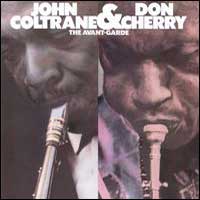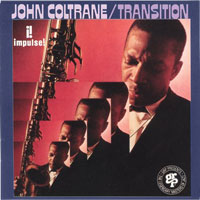Eine tatsächliche Sensation. Eine komplett unveröffentlichte Studio-LP, am 6.3.1963 mit dem klassischen Quartet in seiner Blütezeit aufgenommen, die Mastertapes gingen verloren, im Nachlaß seiner 1. Ehefrau fand sich ein Referenz-Band, der Sound richtig gut (mono). Die einfache LP/CD-Version enthält 7 Titel: 2 sind völlig unbekannte Originale (bei beiden spielt er Sopran-Sax), unbenannt, das eine swingend im typischen Trane-Sound der Zeit, das andere schon ziemlich spirituell, melodisch ausgezeichnet, ein bischen Latin-Flair – ein echtes großartiges Highlight! Auch „Slow Blues“ (mit 11 Min. längster Track) kannte man nicht; ja, langsam und mächtig bluesig, doch zugleich agil, emotional, sehr gehaltvoll, in der 1. Hälfte ohne Piano, in der (schnelleren) 2. mit – ein weiterer toller Höhepunkt! Was auch auf Nature Boy zutrifft (das erst 2 Jahre später, wesentlich anders, wieder auftauchte, auf Quartet Plays), dunkel in klasse Atmosphäre, ausnehmend melodiös, wunderschön, ein feinst federnder komplexer Rhythmus, und sehr komprimiert. Wie auch Impressions, Highlight Nr. 4, zwar auf mehreren LPs drauf, aber sonst immer nur live! Gewohnt schnell, ausgesprochen konzentriert (was hier auf die meisten Stücke zutrifft, sehr auffallend!!), einfach packend! Bleiben noch das ebenfalls exzellente One Up One Down (nicht umgekehrt!), das es bislang nur auf Live-Bootleg gab (ganz straight swingend und feurig, BeBop-Tradition klingt an) und Franz Lehars Vilia (relativ konventionell/ein wenig 50s-angelehnt, wiederum hoch melodisch). Dessen Alternativ-Version auf der Deluxe-Edition (es gibt 7, auf 41 Min.) ist das einzig bekannte Stück hier (erschien als Bonustrack auf Live At Birdland), die beiden Fassungen sind jedoch ganz unterschiedlich im Charakter – schon weil 1x mit Tenor-, 1x mit Sopran-Sax gespielt! Was erstaunlicherweise (Trane experimentierte halt gerne) mehrfach vorkommt. Schon deshalb, und weil weitere Einzelheiten erheblich bei den Alternativ-Versionen abweichen (z.B. die Tempi bei 3 Impressions-Bonustakes), ist die Deluxe-Edition wirklich lohnend! Noch ein Wort zur hohen Melodiösität: Dazu trägt bei, daß Trane ungewohnt oft die Themen wiederholt (z.B. nach den Soli). Absolutes Muß, finde ich.
(dvd, Glitterhouse)
Years of canonization have obscured how John Coltrane was at a bit of crossroads in the early '60s, playing increasingly adventurous music on-stage while acquiescing to Impulse!'s desire to record marketable albums. Whenever he could, producer Bob Thiele would capture Coltrane working out new music with pianist McCoy Tyner, drummer Elvin Jones, and bassist Jimmy Garrison. One of these sessions happened at Rudy Van Gelder's New Jersey studio on March 6, 1963, when Coltrane's quartet was in the thick of a residency at New York's Birdland and just before they were scheduled to cut an album with vocalist Johnny Hartman. John Coltrane and Johnny Hartman appeared in record stores in July 1963, but apart from "Vilia," which popped up on an Impulse! sampler in 1965, the March 6 session sat on the shelf for decades, eventually getting ditched when the label decided to clear out its vaults in the 1970s. Coltrane's reference tape survived, eventually unearthed by his family and assembled for release as Both Directions at Once by Impulse! in 2018.
Both Directions at Once -- which is available as a single disc and as a double-disc set containing all the alternate takes from the session -- exists on a plane that's somewhere between a rehearsal and a finished album. Two of the original songs are untitled, their melodic themes are perhaps a shade fuzzy, the band is vigorous but loose. It lacks the polish of the albums Impulse! released during Coltrane's lifetime, in other words, but that slight rough edge also lends Both Directions at Once no small share of vitality which, in turn, makes it seem even livelier when compared to the two collaborative LPs the label put out in 1963. Throughout the recordings, the quartet is stretching and testing itself, inching ever closer to the exploratory sound that would define Coltrane's mid-'60s. They're still firmly within the realm of accessible bop here, expanding "Nature Boy" and finding crevices within the bars of "Slow Blues," while the original material -- including "Impressions," which would provide the title track on a subsequent 1963 album -- is conversational yet elliptical, pushing at the boundaries of the expected without truly breaking free. As a historical document, this is a necessary footnote, providing evidence that the experimental side of Coltrane did not lay dormant during the early '60s, but the pleasant surprise is that Both Directions at Once is also enjoyable on its own terms as a long-playing record. Impulse! has sequenced the existing recordings so they have an ebb and flow that mirrors a finished album. Just as impressively, the bonus disc of alternate takes works on its own terms, while also lending an illusion that the first disc is a completed work. And that means Both Directions at Once is truly a rare thing: an important discovery from the vault that's also a blast to hear.
(by Stephen Thomas Erlewine, All Music Guide)

 Plattentipp
Plattentipp 












































